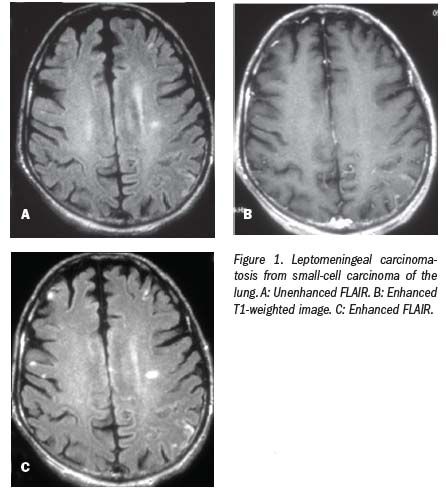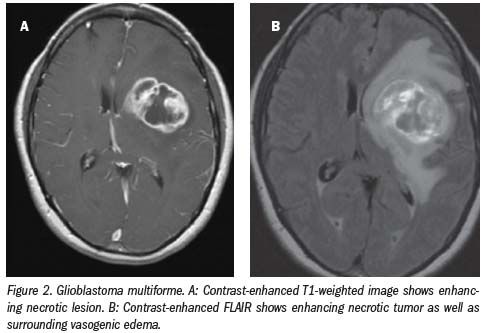Contrast FLAIR tops FLAIR and contrast T1-weighted images
When considering which is the most sensitive MRI technique for detecting disease in the brain, the choice is usually between contrast-enhanced T1-weighted imaging and T2-weighted fluid-attenuated inversion recovery (FLAIR) imaging.
When considering which is the most sensitive MRI technique for detecting disease in the brain, the choice is usually between contrast-enhanced T1-weighted imaging and T2-weighted fluid-attenuated inversion recovery (FLAIR) imaging. Twelve years ago, however, we found that contrast-enhanced FLAIR was actually more sensitive than either,1 particularly for subtle cortical lesions (Figure 1). This sensitivity is likely due to the combination of T2 prolongation, the usual mechanism for parenchymal hyperintensity on FLAIR images, and T1 shortening from the gadolinium chelate. While we normally think of T2 prolongation as the only mechanism for increasing signal intensity on T2-weighted FLAIR images, T1 shortening can also increase signal if it hasn’t maxed out yet. Since T2 prolongation and T1 shortening are synergistic, contrast-enhanced FLAIR is more sensitive for subtle abnormalities than either FLAIR alone or postcontrast T1-weighted imaging alone.

The greatest advantage of contrast-enhanced FLAIR seems to be for detecting subtle cortical abnormalities such as leptomeningeal carcinomatosis (Figure 1), where there is no mass effect. However, it also has an advantage when compared with conventional FLAIR or T2-weighted imaging for deep lesions (Figure 2), where the contrast between the enhancing lesion and the surrounding vasogenic edema is greater than with conventional techniques, and produces very remarkable images.

A reason contrast-enhanced FLAIR is especially sensitive for subtle cortical abnormalities may be that a small amount of gadolinium leaks into the adjacent sulcus. While this may not produce enough T1 shortening to be seen on a T1-weighted image, it may shorten the T1 of cerebrospinal fluid so that it is no longer nulled by the initial 180o pulse in the inversion recovery FLAIR technique.
Contrast-enhanced FLAIR need not take longer than a conventional contrast-enhanced brain study. Since unenhanced FLAIR is usually a part of an MR brain exam, we merely acquire it after contrast is given, rather than before, as is usually done. In the beginning we would acquire T1-weighted images with and without contrast as well as FLAIRs with and without contrast. However, with time, we found we did not need the precontrast FLAIR. Comparing T1-weighted images pre- and postcontrast demonstrated enhancement, and any additional signal on the contrast-enhanced FLAIR we found to be due to T2 prolongation. Since most enhancing lesions generally also produce vasogenic edema, which prolongs T2, the two contrast mechanisms are synergistic.
When reading out brain studies performed with contrast enhancement, I usually read the contrast-enhanced FLAIRs first. If they are normal, it is unlikely that the enhanced T1-weighted images or the unenhanced FLAIRs will add anything. If they are abnormal, the pre- and post–T1-weighted images can sort out whether the brightness on the contrast-enhanced FLAIRs is due more to contrast enhancement or T2 prolongation.
GE HealthCare Debuts AI-Powered Cardiac CT Device at ACC Conference
April 1st 2025Featuring enhanced low-dose image quality with motion-free images, the Revolution Vibe CT system reportedly facilitates improved diagnostic clarity for patients with conditions ranging from in-stent restenosis to atrial fibrillation.
The Reading Room Podcast: Current Perspectives on the Updated Appropriate Use Criteria for Brain PET
March 18th 2025In a new podcast, Satoshi Minoshima, M.D., Ph.D., and James Williams, Ph.D., share their insights on the recently updated appropriate use criteria for amyloid PET and tau PET in patients with mild cognitive impairment.